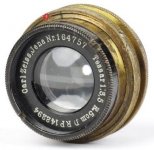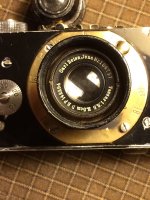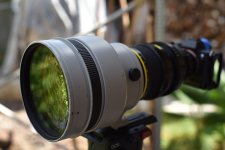Ambro51
Collector/Photographer
When I built up UR Leica to “working”, I searched for, and found, Barnacks initial trial optic. He used the same lens that was on the movie camera, the Zeiss Kino Tessar f 3.5 5cm. This was the fastest Tessar lens of that size, and exclusive to Cine Cameras. The of Style lettering and serial number date it to 1911. Amazingly, the lens threaded right into the UR barrel, and when that inner barrel was retracted to the lip of the outer barrel, the camera was in perfect focus!!
Attachments
hilltime
Well-known
Interesting that they called it the "Visitronic," as I think that was the name they eventually used on the autofocus module that they licensed to several camera companies early in the AF era, wasn't it?
This camera is definitely not AF, but I believe you are correct about Honeywell's AF technology and the use of the "Visitronic" name.
p.giannakis
Pan Giannakis
What? No Alpa(s) yet?
p.giannakis
Pan Giannakis
This is the most rare camera i own. An early model black Minolta SR-1- not easy to come across one. The later SR-1 with the meter bracket are a bit more common.
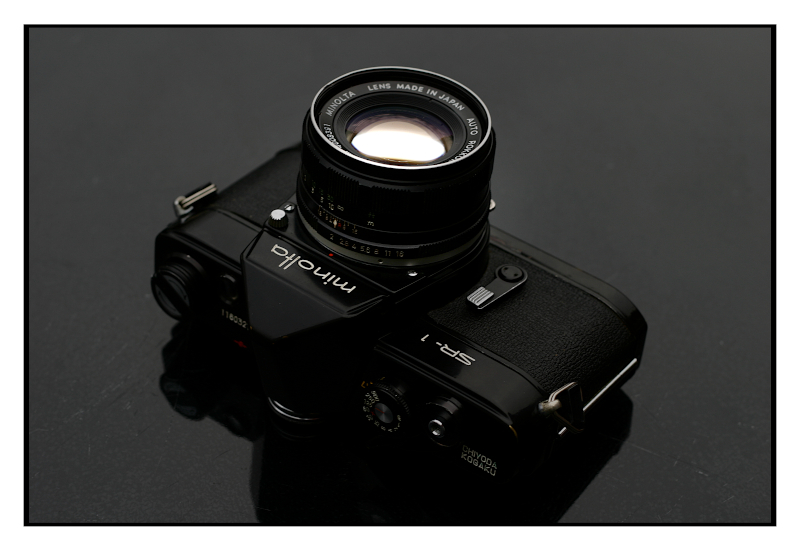

Erik van Straten
Mentor
Days go by without me seeing the same camera and lens of anyone.
Erik.
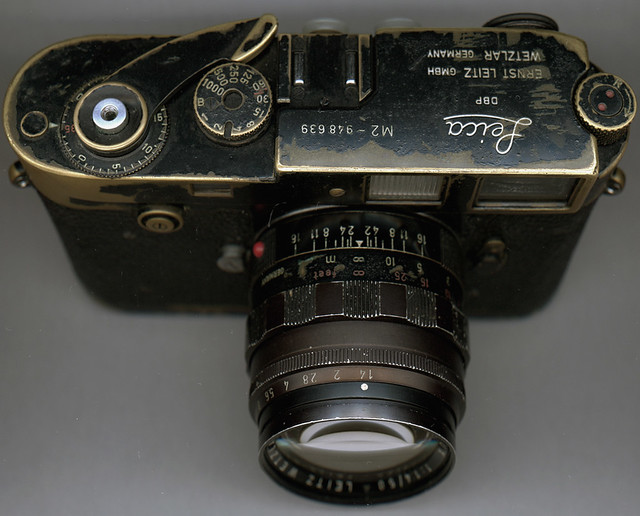
Erik.



Personal Opinion- the original Nikon F mirror-up was designed for the highest speed setting of the F36 Motor Drive. The mirror stays down until you trip the shutter, then stays in the up position- which also allows the fastest firing speed.
But- it also means wasting one shot to just raise the mirror.
Questar and Others offered a Modified Nikon F with a true mirror-up release, the extra small button on this pair of Nikon F bodies. Bought with Questar Telescopes some 50 years ago.
Here's another rare collapsible, this one came on a Canon S-II Barnack.

I worked on one of these before- cleaned up nicely.
For SG-1 Fans, "The First Prime of Nikon"
Canon 50mm F2.2, made for about 6 months, 4000 or so manufactured.
This is a double-Gauss where the group behind the aperture of the typical 1-2-2-1 was combined into a big element of greater power. It is a 1-2-1-1, 5 elements in 4 group design.
 Canon 50mm F2.2 by fiftyonepointsix, on Flickr
Canon 50mm F2.2 by fiftyonepointsix, on Flickr
These used to go for over $600. Prices are way down, and it is an affordable and very usable lens.
This one is the 89th made,
 Canon 50mm F2.2 by fiftyonepointsix, on Flickr
Canon 50mm F2.2 by fiftyonepointsix, on Flickr
And has perfect glass. I've not seen Ebay examples showing etched/damaged glass that affects other Canon lenses.
Very nice colors and rendering-
 Canon 50/2.2 test, Wide-Open by fiftyonepointsix, on Flickr
Canon 50/2.2 test, Wide-Open by fiftyonepointsix, on Flickr
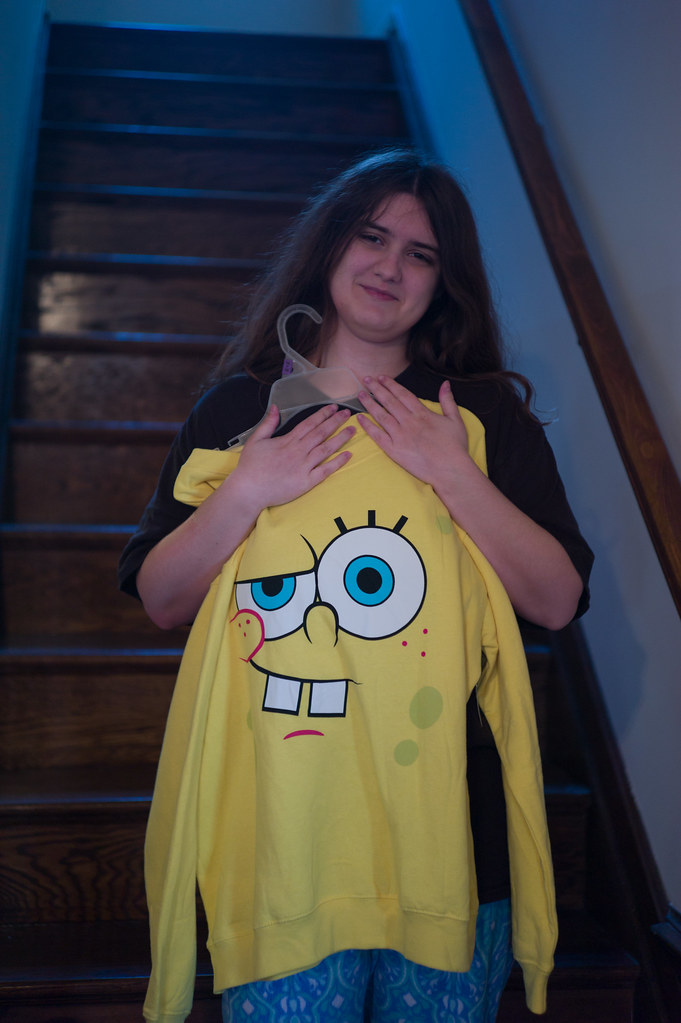 Canon 50/2.2 test, Wide-Open by fiftyonepointsix, on Flickr
Canon 50/2.2 test, Wide-Open by fiftyonepointsix, on Flickr
Uncommon- who wants an F2.2 lens? Marketing error some 60 years ago. The price has dropped well under $200 on these.
This is a double-Gauss where the group behind the aperture of the typical 1-2-2-1 was combined into a big element of greater power. It is a 1-2-1-1, 5 elements in 4 group design.
 Canon 50mm F2.2 by fiftyonepointsix, on Flickr
Canon 50mm F2.2 by fiftyonepointsix, on FlickrThese used to go for over $600. Prices are way down, and it is an affordable and very usable lens.
This one is the 89th made,
 Canon 50mm F2.2 by fiftyonepointsix, on Flickr
Canon 50mm F2.2 by fiftyonepointsix, on FlickrAnd has perfect glass. I've not seen Ebay examples showing etched/damaged glass that affects other Canon lenses.
Very nice colors and rendering-
 Canon 50/2.2 test, Wide-Open by fiftyonepointsix, on Flickr
Canon 50/2.2 test, Wide-Open by fiftyonepointsix, on Flickr Canon 50/2.2 test, Wide-Open by fiftyonepointsix, on Flickr
Canon 50/2.2 test, Wide-Open by fiftyonepointsix, on FlickrUncommon- who wants an F2.2 lens? Marketing error some 60 years ago. The price has dropped well under $200 on these.
p.giannakis
Pan Giannakis
Days go by without me seeing the same camera and lens of anyone.
Erik.

The wear of this camera adds to its beauty!
dexdog
Mentor
Canon 19mm f3.5 in LTM and it's equally scarce finder on my Canon L1. According to Peter Kitchingman's oustanding book on Canon RF lenses, the hypothetical number produced is 2280, but actual number is likely lower. My lens is the highest serial number in Peter's book, which gives end of production in January 1974.


newst
Well-known
My Twofer...
A Leotax Merite (also listed as Merit) which is a subset of the TV2 production line that incorporates a self timer not present on the TV2. I haven’t found exact production numbers but online sources say, vaguely, that up to 2,000 of the TV2/Merite were manufactured.
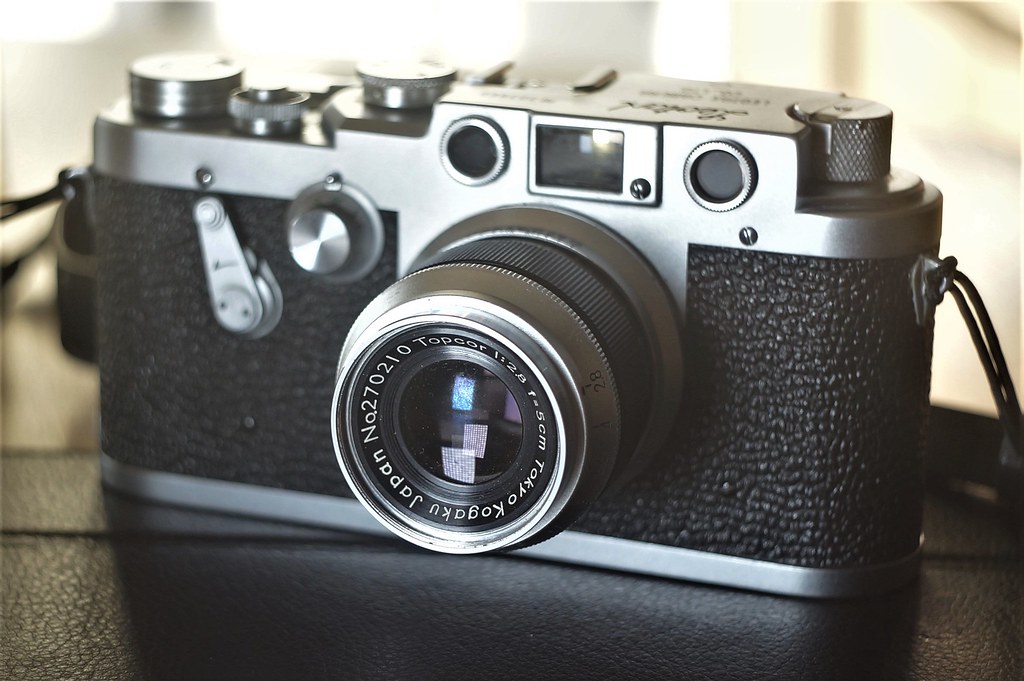 DSC00593 by newst54, on Flickr
DSC00593 by newst54, on Flickr
 DSC00594 by newst54, on Flickr
DSC00594 by newst54, on Flickr
Mounted on the camera is a Topcor 2.8/50. The fact is that I haven’t found a lot of information concerning this lens. Even the Topcon Club website, as you can see, doesn’t have much. Beyond it being a Heliar design, and a damned good performer, I can’t add much information. I would be happy if someone who does know something about this lens would share.
 Topcor 50-28 Description by newst54, on Flickr
Topcor 50-28 Description by newst54, on Flickr
 Topcor 50-28 diagram by newst54, on Flickr
Topcor 50-28 diagram by newst54, on Flickr
A Leotax Merite (also listed as Merit) which is a subset of the TV2 production line that incorporates a self timer not present on the TV2. I haven’t found exact production numbers but online sources say, vaguely, that up to 2,000 of the TV2/Merite were manufactured.
 DSC00593 by newst54, on Flickr
DSC00593 by newst54, on Flickr DSC00594 by newst54, on Flickr
DSC00594 by newst54, on FlickrMounted on the camera is a Topcor 2.8/50. The fact is that I haven’t found a lot of information concerning this lens. Even the Topcon Club website, as you can see, doesn’t have much. Beyond it being a Heliar design, and a damned good performer, I can’t add much information. I would be happy if someone who does know something about this lens would share.
 Topcor 50-28 Description by newst54, on Flickr
Topcor 50-28 Description by newst54, on Flickr Topcor 50-28 diagram by newst54, on Flickr
Topcor 50-28 diagram by newst54, on FlickrThat Topcor 5cm F2.8 is very similar to the Schneider Super-Xenar 5cm F2.8. Did not know about that one!


I did not know about 5-element Xenars until I found a Karat-Xenar 5cm F2.8, fully coated, at a camera show for $30. It was loose- but had an aperture ring. I mounted it to a focus mount from a Canon 50/2.8 with badly etched glass.

So this one- rare lens, uncommon mount, and one of a kind.


I did not know about 5-element Xenars until I found a Karat-Xenar 5cm F2.8, fully coated, at a camera show for $30. It was loose- but had an aperture ring. I mounted it to a focus mount from a Canon 50/2.8 with badly etched glass.

So this one- rare lens, uncommon mount, and one of a kind.
hilltime
Well-known
The whole line up of later Leotax bodies can become quite confusing as their designations can seem quite similar. Starting with the TV, released in 1957, which is 1/500 sec and self timer. It was followed in 1958 with the T2, 1/500 sec and no self timer. Then the K3, 1/500 sec, no self timer, no slow speeds. In 1958, the FV was released with 1000/sec top speed and self timer. It was soon followed by the TV2 (Merite), 1500/sec and self timer. This camera was never called the Merite until the T2L (Elite) was released in 1959 which had 1/500/sec and self timer. Last but not least, the final Leotax G was done but very few were sold or produced as Leotax fell victim to the Japanese camera recession of 1960 which took down many companies which had produced cameras through the 50's.
As to the 5cm/F2.8 lens, I can't add much as the description provided pretty much gives it's specs. I know it is a very good lens, as I have one, but truly how much better than the Topcor 5cm/F2, or the very rare Topcon 5cm/F1.8, I can't comment. Love all the Topcor lenses of the period as I have the 3.5cm/F2.8, the two 50's mentioned, a 9cm/F3.5 and a quite rare 135.5cm/F3.5.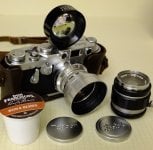
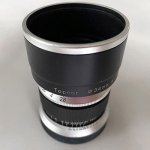
As to the 5cm/F2.8 lens, I can't add much as the description provided pretty much gives it's specs. I know it is a very good lens, as I have one, but truly how much better than the Topcor 5cm/F2, or the very rare Topcon 5cm/F1.8, I can't comment. Love all the Topcor lenses of the period as I have the 3.5cm/F2.8, the two 50's mentioned, a 9cm/F3.5 and a quite rare 135.5cm/F3.5.


Three MIOJ Screw Mount cameras.
Nicca III, Leotax D-IV (4-Digit SN), and Canon III.



The Nicca has the Made in Occupied Japan on the base, near the release, The Leotax has it engraved and filled in with Paint.
The Canon III: you have to remove the cover from the two-piece leather case to find "Made in Occupied Japan" hidden under the flap.
The Leotax came with the Simlar 5cm F1.5, the Nicca III came with the collapsible Nikkor 5cm F2, and the Canon III came with the Nikkor-SC 5cm F1.5.
Nicca III, Leotax D-IV (4-Digit SN), and Canon III.



The Nicca has the Made in Occupied Japan on the base, near the release, The Leotax has it engraved and filled in with Paint.
The Canon III: you have to remove the cover from the two-piece leather case to find "Made in Occupied Japan" hidden under the flap.
The Leotax came with the Simlar 5cm F1.5, the Nicca III came with the collapsible Nikkor 5cm F2, and the Canon III came with the Nikkor-SC 5cm F1.5.
Noserider
Christiaan Phleger
Bingley
Mentor
Canon 50mm F2.2, made for about 6 months, 4000 or so manufactured.
This is a double-Gauss where the group behind the aperture of the typical 1-2-2-1 was combined into a big element of greater power. It is a 1-2-1-1, 5 elements in 4 group design.
Canon 50mm F2.2 by fiftyonepointsix, on Flickr
These used to go for over $600. Prices are way down, and it is an affordable and very usable lens.
This one is the 89th made,
Canon 50mm F2.2 by fiftyonepointsix, on Flickr
And has perfect glass. I've not seen Ebay examples showing etched/damaged glass that affects other Canon lenses.
Very nice colors and rendering-
Canon 50/2.2 test, Wide-Open by fiftyonepointsix, on Flickr
Canon 50/2.2 test, Wide-Open by fiftyonepointsix, on Flickr
Uncommon- who wants an F2.2 lens? Marketing error some 60 years ago. The price has dropped well under $200 on these.
Nice!! Our friend and colleague Colton Allen has many photos in his feed taken with the Canon 50mm f2.2. My copy of this lens is the one shown in Peter Kitchingham’s book on Canon lenses; very beat up cosmetically, but the glass is in great shape. This is a really nice lens for color film.
The Nicca has the Made in Occupied Japan on the base, near the release,
What’s the serial of the Type III, Brian?
Mr_Flibble
In Tabulas Argenteas Refero
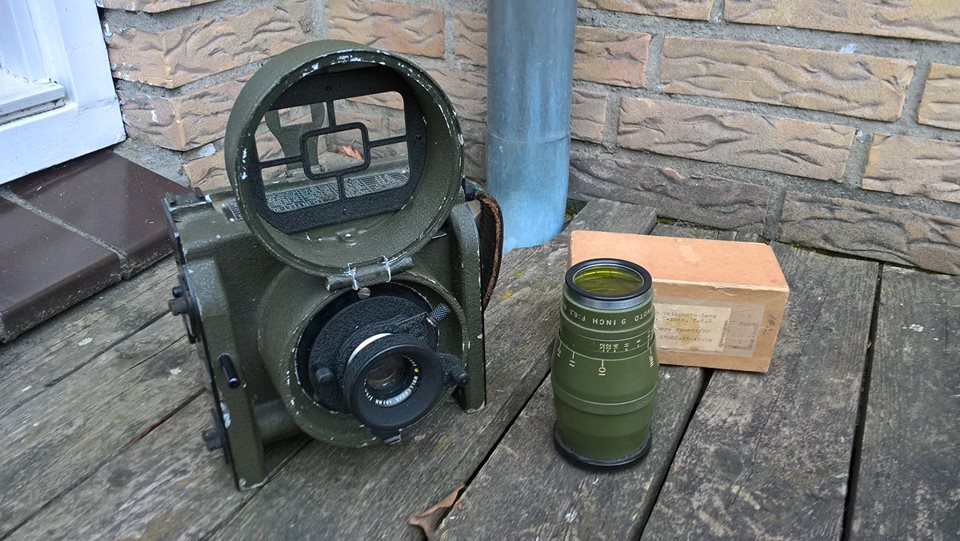
Simmon Brothers Combat Camera, only about 250 made.
The Nicca is Sn 25486- The Leotax D-IV is 9188. The Leotax must have changed SN number scheme, or there are many more made than published online.
Share:
-
This site uses cookies to help personalise content, tailor your experience and to keep you logged in if you register.
By continuing to use this site, you are consenting to our use of cookies.


